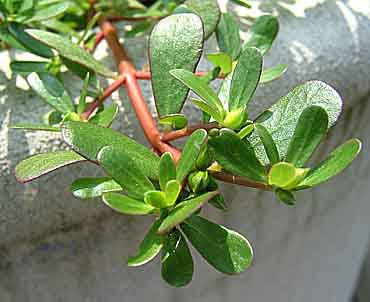Tough and Tasty: Recasting a Resilient Weed as a Wild Edible
From http://www.wildmanstevebrill.com/Plants.Folder/Purslane.html
I don’t know of any resource which analyzes every single weed out there for nutrients, calories, etc.
However it seems weeds could be a good addition to one’s diet.
And a great addition to the urban garden.
From the 30 July 2013 article at Quest- Exploring the Science of Sustainability
If a farmer told you not to pull a weed, would you be worried about him? Maybe you’d insist he get out of the heat and drink some water, or take a vacation.
Believe it or not, that farmer may have good reason to protect his weeds.
In the middle of July 2012, the costliest drought in recorded history had Nebraska in its grip. Not a sprinkle of rain had fallen on Ross Brockley’s farm since June 4, and wouldn’t again until July 31. His half-dozen acres of vegetable gardens were green thanks only to constant watering by hand and diligent weeding performed by Brockley, his wife, Barb, and me, his lone farmhand.
Here in the southeast corner of the state, residents had spent their summer watching scorched soil crack and fields of crops turn brown. On this particular day I noticed a very healthy plant in an empty garden bed. It didn’t resemble anything I recognized as food so I pulled it up.
Even amid the dead stalks of drought-stricken corn, purslane was defiantly rearing its little red branches.
“Don’t do that!” Brockley yelped from across the garden. “I’m saving it,” he said sternly. “We’ll eat that.”
Really?
The plant looked like a bundle of long red worms, each with several green oval-shaped cartoon ears. It looked more like something suited for a compost pile than a cultivated garden. This drought had clearly taken a toll on Brockley’s mental state.
He picked up the plant I had just discarded, broke off two stems, and put one in his mouth. He held the other in front of my face, indicating that I was to follow his lead.
“It’s purslane,” he said as he chewed, “and it’s primo!”
I hesitantly took a bite and chewed it slowly. “Peppery,” I thought. The crunch felt like a snap pea with the skin of an apple. Then came a blast of citrus flavor. I would have told Brockley that I enjoyed it, but I couldn’t bring myself to interrupt his obvious state of food bliss. I simply looked on as he finished eating the entire plant…
…
Kay Young is a local legend among plant people. In 1993, she authored Wild Seasons: Gathering and Cooking Wild Plants of the Great Plains, and has been active in Lincoln’s gardening community for decades. The 82-year-old has dedicated her life to local folklore, horticulture, and ethnobotany. A quick tour of her backyard revealed a variety of nurtured plants that one would expect to see in a yard-waste bin…
…
“If you make a sandwich with mayonnaise or salad dressing, it doesn’t get wimpy the way lettuce does,” she said of purslane’s hardy leaves. “And in the summer, when the lettuce is getting bitter, purslane is still just wonderful.”..
…
A study by the Center for Genetics, Nutrition and Health, a nonprofit research organization in Washington, D.C., states that purslane is the “richest source of omega-3 fatty acids of any green leafy vegetable yet examined.”
“Purslane comes from India, where it was a food crop centuries ago. It was Gandhi’s favorite food. Now it also grows across America, and around the world.”
Related articles
- Tough and Tasty: Recasting a Resilient Weed as a Wild Edible (science.kqed.org)
- Purslane – Weed It or Eat It? (oshkoshfoodcoop.com)
- Purslane: A Prolific Prepper Powerhouse (survivalsherpa.wordpress.com)
- Renewed interest in wild edibles (greenreview.blogspot.com)
- Foraging: 52 Wild Plants You Can Eat (realfarmacy.com)
- Delicious, edible weeds (palexrs.wordpress.com)
- Smart Organic Horticulture Ideas For A Healthier Garden! (diariesofarealtor.wordpress.com)
- One person’s weed… (unexpectedincommonhours.wordpress.com)
- Wild Edibles: Dandelion (wisewildflower.wordpress.com)


I love purslaine! I wish I could get some here. One of the farmers at the organic farmers market in Toronto used to bring some in occasionally. A gourmet treat!
Thanks for the comment.
And to think last week I removed a bunch from the cracks in our sidewalks. Would have been edible, since we refuse to use insecticides, pesticides, and chemicals on our property!
Well, if Toledo, Ohio was closer to Toronto…I’d offer some of our next “crop”!
Thank you! I am no longer in Toronto, but am now in the suburbs of Ottawa where they use a lot of (illegal) pesticides in my neighborhood, so even if I did see some purslaine around here, I wouldn’t eat it. My own yard/garden is tiny, and the previous person had red dyed wood chips as mulch, so I couldn’t grow any food there. My body doesn’t do well with contaminants.
PS, I missed a turn driving between Toronto to Yellow Springs once, and ended up circling Toledo!
Next time you circle Toledo, I’ll find a decent restaurant which serves organic. My treat. We’ve got to have one here..
Thank you for the pingback. You have a very interesting blog!
You’re welcome. Been getting quite a few comments thru posting your article on Facebook.
Will definitely try some with our next “crop” here between the sidewalk cracks.
Nice of you to say the blog is interesting. I’ve been learning a lot by just skimming health/medical news and such…
and coming across articles as yours.
Thank you again. (I wish purslane grew here between the sidewalk cracks.) 🙂